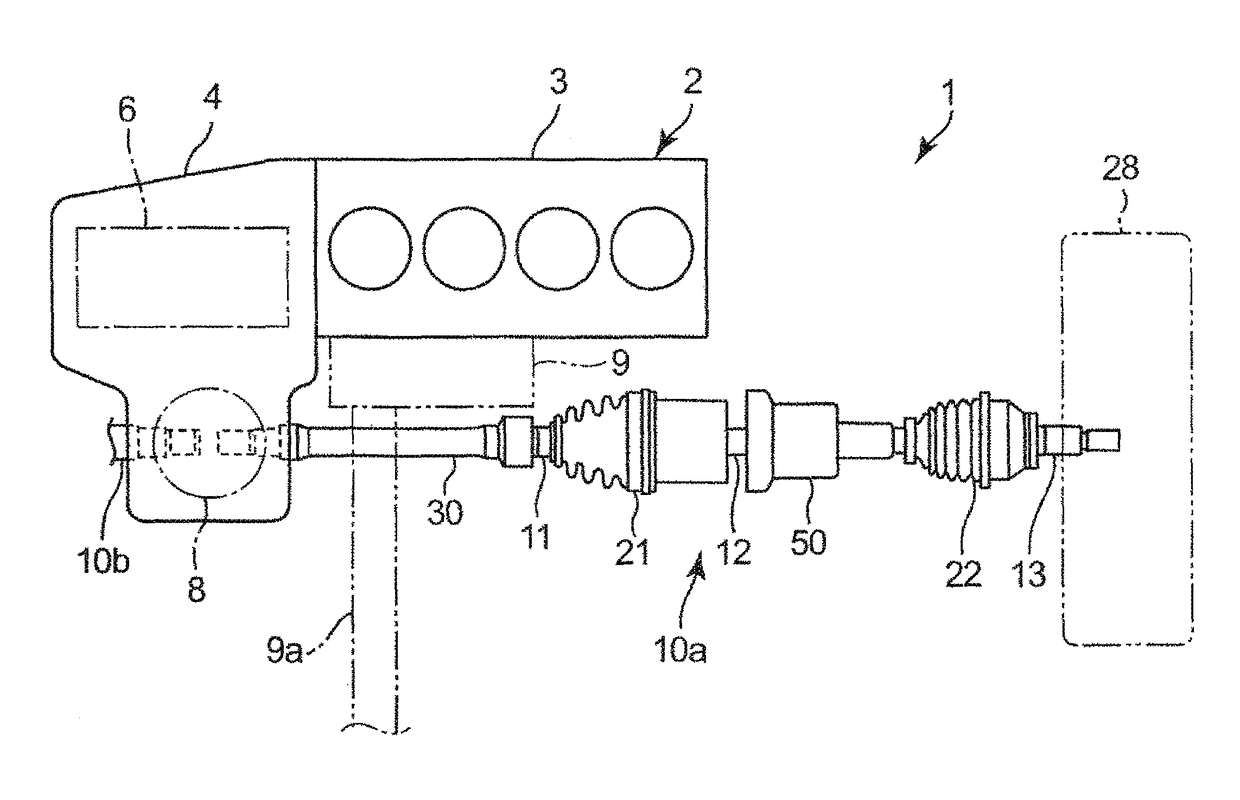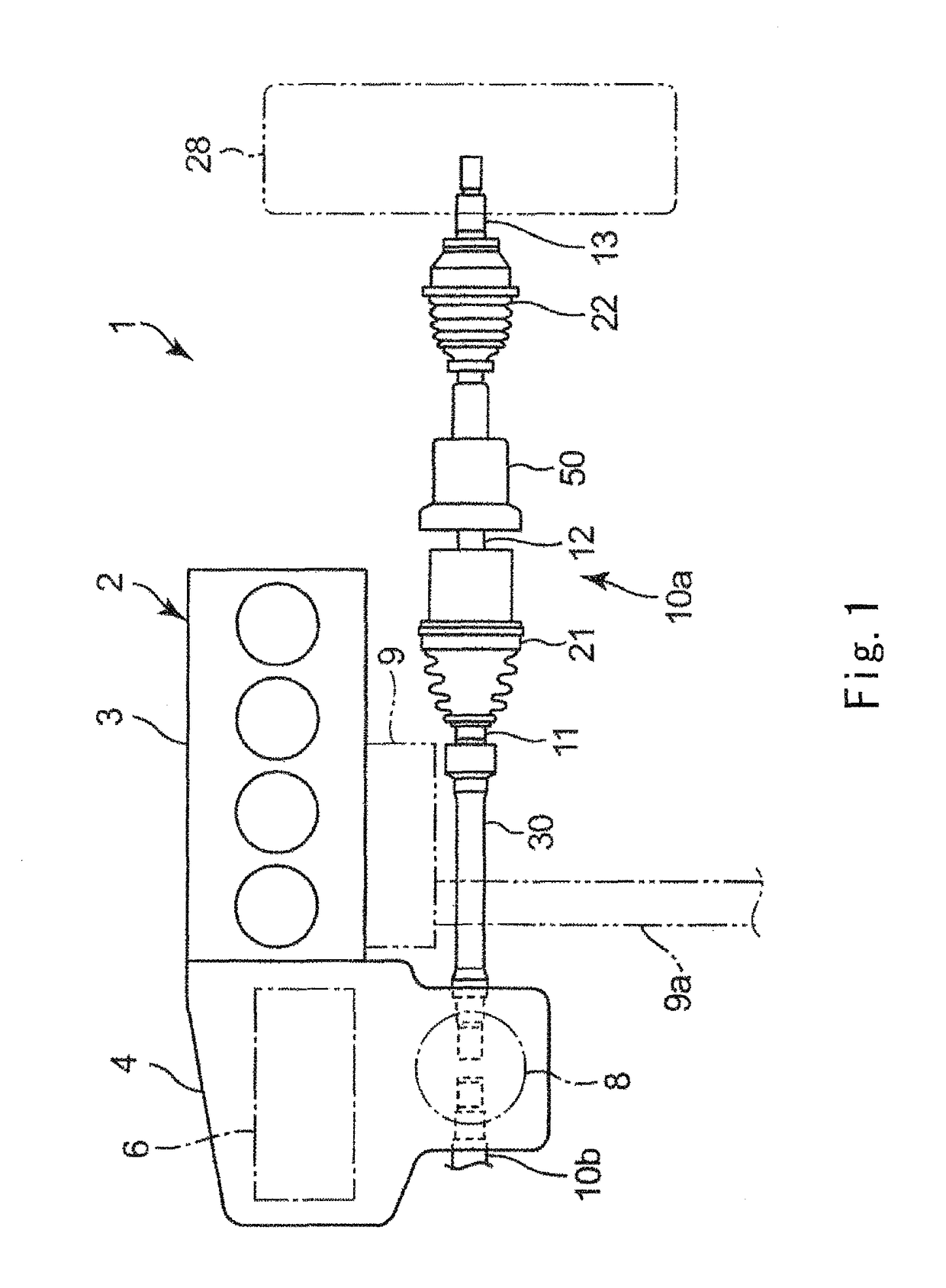Power transfer structure of vehicle
a technology of power transfer and vehicle, which is applied in the direction of jet propulsion mounting, couplings, transportation and packaging, etc., can solve the problems of increasing vibrations and noise in the interior of the vehicle and effectively achieving a vibration damping function. , to achieve the effect of effectively absorbing torsional vibration, increasing the size of the vehicl
- Summary
- Abstract
- Description
- Claims
- Application Information
AI Technical Summary
Benefits of technology
Problems solved by technology
Method used
Image
Examples
embodiment 1
[0060]FIG. 1 is a plan view showing a power transfer device 1 of a vehicle according to Embodiment 1. FIG. 2 is a schematic diagram showing the power transfer device 1 when the power transfer device 1 is viewed from a rear side of the vehicle.
[0061]As shown in FIGS. 1 and 2, the power transfer device 1 is mounted on a front engine-front drive vehicle (FF vehicle). For example, the power transfer device 1 includes: a power source 2 mounted on an engine room; and a pair of right and left drive shafts 10 (10a and 10b) configured to couple right and left driving wheels 28 to the power source 2.
[0062]The power source 2 includes a transversely mounted type engine 3 and a transaxle 4 provided at a left side of the engine 3 in a vehicle width direction. An exhaust apparatus 9 including an exhaust pipe 9a extending rearward is connected to the engine 3. The transaxle 4 includes: a transmission 6 coupled to an output shaft of the engine 3 through, for example, a torque converter (not shown); ...
embodiment 2
[0095]Next, Embodiment 2 of the present invention will be explained in reference to FIGS. 7 to 9. In Embodiment 2, detailed explanations of the same components as in Embodiment 1 are omitted. In FIGS. 7 to 9, the same reference signs are used for components having the same functions as in Embodiment 1.
[0096]In Embodiment 2, a second high-frequency damper 80 as a third damper is provided on the drive shaft 10a in addition to the low-frequency damper 30 and the high-frequency damper 50 which are the same as those in Embodiment 1. Embodiment 2 is the same in configuration as Embodiment 1 except that the second high-frequency damper 80 is added.
[0097]As with Embodiment 1, the low-frequency damper 30 is provided on the differential-side shaft 11, and the high-frequency damper 50 (hereinafter may be referred to as a “first high-frequency damper 50”) is provided on the intermediate shaft 12. Then, the second high-frequency damper 80 is provided on the wheel-side shaft 13.
[0098]One example ...
embodiment 3
[0111]Hereinafter, Embodiments 3 to 5 of the present invention will be explained in reference to FIGS. 10 to 12. In Embodiments 3 to 5, detailed explanations of the same components as in Embodiments 1 and 2 are omitted. In FIGS. 10 to 12, the same reference signs are used for components having the same functions as in Embodiments 1 and 2.
[0112]In Embodiment 1 described above, among the differential-side shaft 11, the intermediate shaft 12, and the wheel-side shaft 13 constituting the drive shaft 10a, the dampers 30 and 50 are provided on the differential-side shaft 11 and the intermediate shaft 12, respectively. In Embodiment 2 described above, the dampers 30, 50, and 80 are provided on the shafts 11, 12, and 13, respectively. However, in the present invention, dampers are only required to be provided on at least two shafts, as in Embodiments 3 to 5 explained below, for example.
[0113]In Embodiment 3 shown in FIG. 10, the two dampers 30 and 80 are provided on the drive shaft 10a. Spe...
PUM
 Login to View More
Login to View More Abstract
Description
Claims
Application Information
 Login to View More
Login to View More - R&D
- Intellectual Property
- Life Sciences
- Materials
- Tech Scout
- Unparalleled Data Quality
- Higher Quality Content
- 60% Fewer Hallucinations
Browse by: Latest US Patents, China's latest patents, Technical Efficacy Thesaurus, Application Domain, Technology Topic, Popular Technical Reports.
© 2025 PatSnap. All rights reserved.Legal|Privacy policy|Modern Slavery Act Transparency Statement|Sitemap|About US| Contact US: help@patsnap.com



